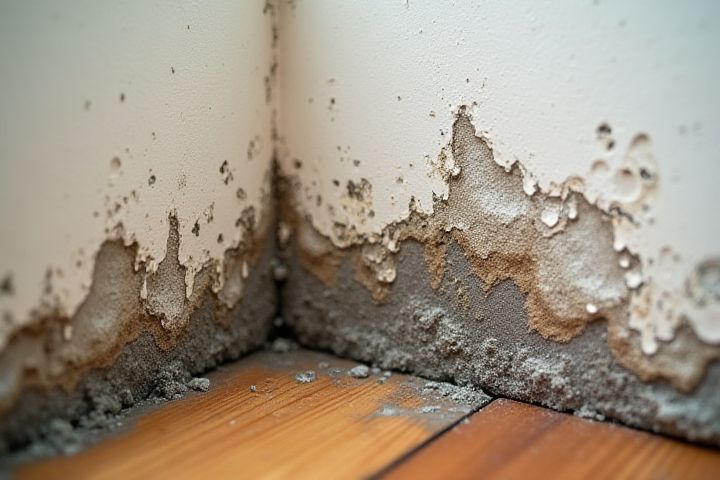
To effectively remove mold from your house, begin by identifying the source of moisture that supports mold growth, as addressing this is crucial for long-term prevention. Use protective gear such as gloves, masks, and goggles to ensure your safety while cleaning. For small areas, employ a mixture of water and detergent or a specialized mold remover to scrub affected surfaces; this includes walls, ceilings, and any porous materials like carpets or drywall. If the mold infestation is extensive, consider consulting professional mold remediation services to ensure thorough and safe removal. After cleaning, increase ventilation in your home and use dehumidifiers to maintain lower humidity levels, thus reducing the likelihood of mold resurgence.
How To Get Mold Out Of A House
Identify and address water leaks
Identifying and addressing water leaks is crucial for mold remediation in your home. Start by inspecting areas prone to moisture, such as basements, bathrooms, and kitchens, looking for signs of water damage, such as discoloration or peeling paint. Use a moisture meter to detect hidden leaks within walls or ceilings, targeting any readings above 20% humidity. Once identified, promptly repair leaks in plumbing or roofing to eliminate the source of moisture, significantly reducing mold growth risk and promoting a healthier indoor environment.
Improve ventilation and airflow
Improving ventilation and airflow in your home is crucial for mold prevention and removal. You can achieve this by regularly opening windows to create cross-ventilation, allowing fresh air to circulate and reduce moisture levels. Installing exhaust fans in areas prone to humidity, such as kitchens and bathrooms, can effectively expel excess moisture, ensuring a drier environment. Using dehumidifiers with a capacity of 30 to 50 pints per day can further manage indoor humidity levels, ideally keeping it between 30% and 50%, which is less conducive to mold growth.
Use mold-killing solutions such as vinegar or hydrogen peroxide
To effectively eliminate mold from your home, utilize mold-killing solutions like vinegar or hydrogen peroxide. White vinegar, an all-natural antiseptic, can be sprayed directly onto the moldy area, allowing it to sit for at least an hour before wiping it away with a damp cloth. Alternatively, a solution of hydrogen peroxide at concentrations of 3% can be applied, letting it sit for around 10 minutes to penetrate the mold before scrubbing off. These solutions not only eradicate mold but also help in preventing future growth when used regularly in damp areas.
Remove and replace affected materials like drywall or carpet
To effectively remove mold from your home, focus on removing and replacing affected materials, particularly drywall and carpet. Begin by identifying areas where moisture accumulation has led to mold growth; this is often seen in basements, bathrooms, or areas with past water damage. For drywall, cut out sections that are contaminated, ensuring to extend beyond visible mold, and dispose of them securely to prevent spreading spores. When it comes to carpets, if the mold has penetrated deeply, complete replacement is recommended, as cleaning may not eliminate all spores and could lead to recurring mold issues.
Dry wet areas promptly
To effectively eliminate mold from your home, promptly address wet areas, as mold thrives in moisture-rich environments. Use a solution of water and detergent to scrub surfaces where mold appears, ensuring to wear protective gear such as gloves and a mask. After cleaning, dry the affected areas completely, ideally within 24 to 48 hours, to prevent mold recurrence. For persistent mold issues, consider using a commercial mold remover or consulting a professional for thorough remediation.
Use dehumidifiers to decrease humidity
Using dehumidifiers can effectively reduce humidity levels in your house, helping to combat mold growth. Aim to maintain indoor humidity below 50% to create an unfavorable environment for mold spores. Place dehumidifiers in areas prone to dampness, such as basements, bathrooms, and kitchens, to optimize moisture removal. Regularly empty the water reservoir or use a continuous drain option to ensure efficient operation.
Clean and disinfect with mold removal sprays
To effectively remove mold from your home, start by cleaning the affected areas with specialized mold removal sprays that contain EPA-approved ingredients. These sprays typically have active compounds like hydrogen peroxide or quaternary ammonium compounds, which can eliminate mold spores and prevent future growth. It's crucial to apply the spray generously, allowing it to penetrate the surface for 10 to 15 minutes before scrubbing. After cleaning, ensure that you disinfect the area with a solution of one cup of bleach to one gallon of water to further inhibit mold regrowth.
Ensure proper drainage around the home
Proper drainage is crucial for preventing mold growth in your home. Ensure that gutters and downspouts are clean and direct water at least 6 feet away from the foundation to minimize moisture accumulation. Landscaping should slope away from your house to facilitate water runoff, preventing pooling near the walls. Regularly inspect these areas, as maintaining effective drainage can significantly reduce the risk of mold issues, saving you both time and money in mold remediation.
Seal cracks and gaps in basements or walls
Sealing cracks and gaps in basements or walls is crucial for mold prevention, as it reduces moisture intrusion. Use a high-quality silicone or polyurethane caulk, which has a lifespan of up to 20 years, to fill any visible openings, particularly around windows, doors, and plumbing fixtures. Ensure the surfaces are clean and dry before application to achieve the best adhesion and minimize future mold growth. Regularly inspect these seals every 6 to 12 months to maintain a mold-free environment in your home.
Wear protective gear during removal
Wearing protective gear is crucial when removing mold from your home to ensure your safety. Equip yourself with N95 respirators to filter out airborne mold spores, along with goggles to protect your eyes from irritants. Use gloves made of rubber or vinyl to prevent skin contact with mold and its potential toxins. Finally, consider a full-body suit to minimize exposure and keep yourself safe throughout the removal process.
